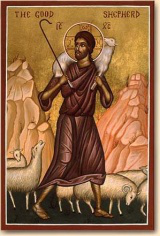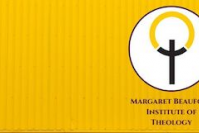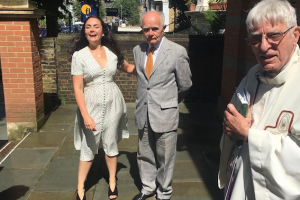Sunday Reflection with Fr Terry - 29 April 2012

19C Anon - Wiki Images
When you see a picture of Jesus the Good Shepherd it usually looks very romantic. The reality for shepherds in his day was rather different. Sheep are not renowned great intelligence. They are easily frightened and confused, and flourish best when there is a guiding hand looking after them. In talking of sheep Jesus is of course talking about us. We can know what is good for us and what is bad for us, and yet we find ourselves heading towards the wrong choice. Similarly the shepherd had to keep a sharp look-out for the sheep who would often stubbornly do the wrong thing. A shepherd had to know their characteristics. This one will tend to wander off alone, that one is lame and lags behind. Jesus, our Good Shepherd knows each of us individually and works with us in our uniqueness. He inspires us but also keeps a canny eye on us at the same time. Each of us can say, no matter how haltingly, that we have a relationship with Jesus Christ, that we know him and that he knows us.
Being a shepherd in Jesus' day was a rather lonely job, low in social status as well. The angels appearing to the shepherds outside Bethlehem signified that the coming of Christ was for all people, high and low alike. It was an isolating job because of the constant need to search for water and good pasture in arid land. The shepherd had to be constantly on the move, taking his flock to new sustenance as soon as they had worn out the pasture where they were. Jesus too had to endure loneliness for the sake of his mission to bring salvation to the flock that he would call from among humankind. He says of himself that while birds of the air had nests and foxes had holes, he had nowhere permanent to lay his head (Lk 9.58).
There was an element of danger. Shepherds had to confront sheep rustlers and wild animals like mountain lions. To be a shepherd took a lot of hard work and some strength of character. When Jesus calls himself the Good Shepherd it indicates his willingness to be with us in the thick of things, guiding and guarding his people. In the Holy Land of Jesus' day the sheep at night were put into a stockade of thorn bushes assembled in the shape of a circle. There was no gate, and at the entrance the shepherd would lay himself across the open space, guarding the sheep. When we hear the words today that the good shepherd is one who lays down his life for his sheep, we know that Jesus is speaking of the price that he will pay for love of his flock. For love of us.
Christ is our pattern, our model. We are used to thinking of ourselves as his sheep. But surely he also calls us to follow him in being good shepherds ourselves. Those of you who are parents will know the importance of watching out for your children's best interests, and of guiding them. Those of you who are supervisors at work will know that you have to balance being fair with being firm - you too have to be shepherds.
But how would we know Christ without specific ministry within the Church? There are those who are called to be priests, and others who are called to the life of a sister. A priest is privileged to stand at the altar and to bring the sacraments to the people of God. A sister witnesses by the offering of her whole life and the dedication that she brings to that. Vocations are fewer today, but there are still those who step forward. Without them how will the name of Jesus Christ be lifted up, how will the flock of the Good Shepherd be fed with the means of sacramental grace which he gave to the Church? Let us not only pray for vocations but encourage them, so that everyone will be able to live out more fully the vocation that we all share: to be Christian.
Fr Terry Tastard is Parish Priest of St Mary's, East Finchley, in north London. For Eastertide you might find useful the palm-size book of meditations which he wrote to accompany the icons of the Resurrection painted by the Russian-trained iconographer Caroline Lees. The book is beautifully illustrated. It is called The Way to Life (St Paul's Publishing: ISBN 085439 721 3) and carries a foreword by Cardinal Cormac Murphy-O'Connor.


















